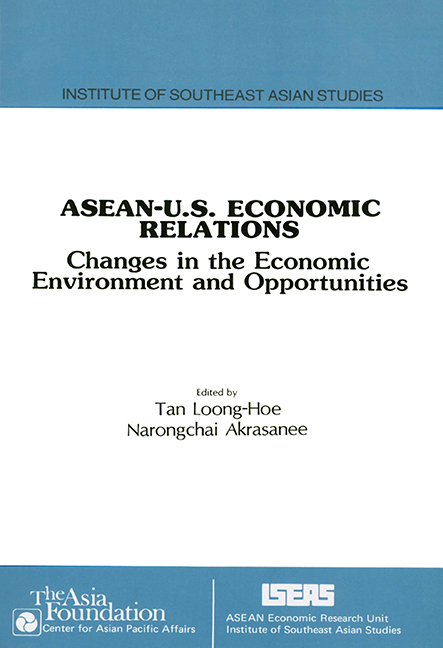Book contents
- Frontmatter
- Contents
- List of Tables
- List of Figures
- Foreword
- Changes in the ASEAN-U.S. Economic Environment and Opportunities: An Introductory Overview
- PART I ECONOMIC TRENDS
- PART II STRUCTURAL ADJUSTMENTS
- 3 Structural Adjustment in ASEAN
- 4 What Kind of Structural Adjustment Policies for U.S. Trade Difficulties?
- PART III TRADE IN SERVICES
- PART IV ROLE OF PRIVATE SECTOR
- THE EDITORS
3 - Structural Adjustment in ASEAN
from PART II - STRUCTURAL ADJUSTMENTS
Published online by Cambridge University Press: 21 October 2015
- Frontmatter
- Contents
- List of Tables
- List of Figures
- Foreword
- Changes in the ASEAN-U.S. Economic Environment and Opportunities: An Introductory Overview
- PART I ECONOMIC TRENDS
- PART II STRUCTURAL ADJUSTMENTS
- 3 Structural Adjustment in ASEAN
- 4 What Kind of Structural Adjustment Policies for U.S. Trade Difficulties?
- PART III TRADE IN SERVICES
- PART IV ROLE OF PRIVATE SECTOR
- THE EDITORS
Summary
In an increasingly interdependent world, where major economic problems and their solutions interrelate with growing complexity and intensity, the economic fortunes and political stability of countries are becoming more and more intertwined. We are thus confronted with an ever-increasing globalization of dangers and challenges which call for domestic policies that transcend the parochial or even national items. Whether we like it or not, more and more of our problems will require a global solution.
Global interdependence is not new to the Association of Southeast Asian Nations. It has been one of the key features of its economic policy and of its external relations. The external orientation of ASEAN countries in general has earned for them growth rates which have been well above world averages since the late 1960s. This achievement, however, could hardly have taken place without OECD participation. The OECD countries, particularly the United States and Japan, have been a major source of foreign capital, technology, and trade for ASEAN countries.
Indeed, the future growth of ASEAN will hinge upon the nature of structural change and adjustment that occurs in the OECD and the Asian NICs. Changes in the international division of labour in accordance with shifting comparative advantages calls for structural adjustment in die developed economies, which would enable industries to be relocated and trade to be restructured.
Nature of Structural Adjustment
Structural adjustment — i.e., the shifting of factors of production to different uses in response to changes in technology, consumer preferences, and international competitiveness — is not just a principle for trade policy; it is an inevitable and necessary part of the process of economic growth. It may, however, be made more urgent as a result of external shocks or inappropriate domestic policies.
Growth has caused ASEAN's internal domestic market to rise 3.1 times in real terms during the past two decades. ASEAN's investment in real terms has expanded 6.3 times within a 20-year period as machinery and equipment had to be set in place and buildings had to be put up.
- Type
- Chapter
- Information
- ASEAN-U.S. Economic RelationsChanges in the Economic Environment and Opportunities, pp. 67 - 88Publisher: ISEAS–Yusof Ishak InstitutePrint publication year: 1988

